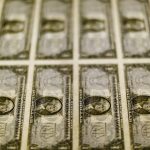LONDON/TOKYO (Reuters) – The dollar edged higher on Wednesday as investors awaited Federal Reserve meeting minutes for more insight on the central bank’s rate path, while the pound jumped after data showed UK inflation fell less than expected in April.
Investors have been shoring up U.S. rate cut bets after a milder inflation reading last week, even as Fed officials have continued to sound a cautious note.
Fed Governor Christopher Waller on Tuesday said he would need to see several more months of good inflation data before he would be comfortable supporting rate cuts.
That timeline was echoed by Cleveland Fed President Loretta Mester.
Ahead of next week’s data, the market will get minutes of the Fed’s April 30-May 1 monetary policy meeting, which will be scrutinised for any “dovish or hawkish undertones masked by the consistency of Fedspeak,” said Andy Ji, senior Asia FX analyst at InTouch Capital Markets.
Markets have about 40 basis points (bps) of easing priced in from the Fed this year versus last week’s 52 bps.
While markets remain hopeful that U.S. inflation will continue to cool, PCE data due on May 31 will be a crucial test, analysts said.
The dollar index was 0.05% higher against a basket of currencies at 104.70, bobbing above a five-week low of 104.07 touched last week.
BOE JUNE CUT FADES
The pound jumped as UK inflation neared the BoE’s target in April, but did not slow as much as expected, prompting investors to pull bets on a rate cut next month. [GBP/]
British consumer prices rose by 2.3% in annual terms in April, slowing from a 3.2% increase in March. The BoE and economists polled by Reuters had forecast an annual rate of 2.1%.
Money markets now see only a 13% chance of a rate cut in June, according to LSEG data. Earlier this week, pricing in derivatives markets suggested traders saw a 55% chance of a first cut coming in June.
Sterling rose 0.16% to $1.2730, after touching a two-month high of $1.2761. The euro fell against the pound to two-month lows and was last down 0.23% on the day at 85.21 pence.
“Front end yields will back up a little so spreads will widen in favour of the pound versus G10 currencies,” said Kenneth Broux head of corporate research, FX and rates at Societe Generale (OTC:SCGLY)
Elsewhere, the Reserve Bank of New Zealand left its benchmark cash rate at 5.5% as expected, but lifted its forecasts for peak interest rates at its latest monetary policy meeting as inflation stays stubbornly high.
It now sees rates peaking at 5.7% at the end of 2024, compared with 5.6% three months ago.
The New Zealand dollar jumped as high as $0.6152, its highest since March 14. It was last up 0.34% versus the greenback at $0.6113.

Fears of currency intervention by Tokyo still had traders on alert after suspected rounds of intervention earlier this month.
Against the yen, the dollar edged up 0.15% to 156.43. The yen was little changed after data showed Japan’s exports rose 8.3% in April from a year earlier.
To read the full article, Click Here

